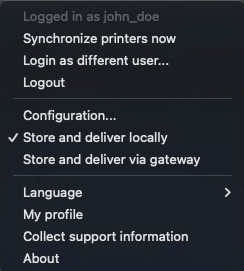Relevant Products
SAFEQ Cloud Client is available in BREEZE PRINT BREEZE MFD PRO PRINT PRO MFD
Secondary gatewaysare available in PRO PRINT PRO MFD
Advanced SAFEQ Cloud Client Deployment and configuration (Job Routing, Local Spooling, Offline Print Rerouting) are available in PRO PRINT PRO MFD
SAFEQ Cloud Client consists of the background service and the frontend application. The service module is responsible for managing print queues, connectivity with SAFEQ Cloud server, printing and storage operations; the frontend part contains user interface for configuration operations.
There are three modes of operation:
-
The local storage mode. SAFEQ Cloud Client connects to the primary server via the persistent channel and performs all print and job storage operations locally. It is also possible to temporarily switch to gateway job delivery using system tray menu, which can be useful in the pull printing scenario when SAFEQ Cloud must be powered off. Local storage mode requires SAFEQ Cloud Client endpoint authorization in the SAFEQ Cloud server. For more details about endpoints, see Endpoints. When user prints, the jobs are stored on the PC. In the case of Citrix or other VDI, it depends on where the SAFEQ Cloud Client is running, specifically the underlying SAFEQ Cloud Client service “SAFEQ Cloud Client Core” runs. Jobs are stored on the Citrix server (where client core service runs) and they will remain there when the thin session is terminated, assuming they have session retention etc configured in their VDI environment.
-
The gateway mode, in which SAFEQ Cloud Client sends all print jobs to the SAFEQ Cloud server, and has no persistent connection to the server. When a user prints, the jobs are delivered from the PC to an SAFEQ Cloud server, either primary or secondary gateway, depending on configuration. Jobs are delivered to printer using a “Document Output” service.
-
The hybrid mode essentially switches modes based on print type. In the case of direct print, SAFEQ Cloud Client will store and deliver jobs locally and in the case of pull (secure print) it will deliver the job via the cloud. This mode requires registration and authorization in the SAFEQ Cloud server (same as local storage mode).
Jobs are delivered from the SAFEQ Cloud Client to the printer directly if the SAFEQ Cloud Client can reach the printer. If the SAFEQ Cloud Client cannot reach the printer, the job will automatically be routed via primary SAFEQ Cloud server to the appropriate “Document Output” service which will then deliver to the printer.
The mode of operation is chosen during installation and can be later changed by using Service setup configuration dialog as explained in section 7.5.1.
Which operation mode to choose depends on the customer solution configuration. If serverless operations are required and there is no primary or secondary SAFEQ Cloud server available on the local network then the SAFEQ Cloud Client should be configured with either local storage and delivery option or hybrid mode. In this case it will connect to the cloud SAFEQ Cloud server for authentication and job reporting purposes. If a local server is available, the SAFEQ Cloud Client may use it in the gateway mode.
In local delivery mode, the computer on which the SAFEQ Cloud Client is running must have a direct connection to the printer, to be able to deliver print jobs to the printer.
Service module is installed as a Windows service on Windows or launched daemon on macOS and runs under a privileged account. The frontend part shows a notification icon in the system tray and provides a default menu:

-
Synchronize printers now – Perform manual printer synchronization.
-
Login as different user... – Perform user authentication against the SAFEQ Cloud server (only visible if the SAFEQ Cloud Client is configured with a custom login authentication type).
-
Logout – Perform user logout from SAFEQ Cloud server and delete synchronized printers.
-
Configuration... – opens a configuration dialog.
-
Store and deliver locally – Switch to local job delivery (only visible if local storage is enabled during installation).
-
Store and deliver via gateway – Switch to gateway job delivery (only visible if local storage is enabled during installation).
-
Language – Submenu to select the UI language from the list of supported languages.
-
My profile – opens a new browser window with My profile.
-
Collect support information – opens a dialog with options to collect logs (useful for troubleshooting).
-
About – shows version and copyright information.
The taskbar icon indicates the current operational state of the SAFEQ Cloud Client:
-

– idle state, connected to SAFEQ Cloud server
-

– error state, no connection to background service (it is stopped or not functioning correctly)
-

– synchronization is currently in progress
-

– offline operation, no connection to SAFEQ Cloud server
SAFEQ Cloud Client will perform printer synchronization automatically based on the synchronization internal option. It is also possible to trigger manual synchronization by right-clicking the taskbar icon and choosing Synchronize printers now menu item.
New printers will appear automatically in the system, matching input ports configured on the server side and can be used immediately for pull or push printing depending on the input port configuration. When running in local storage mode, print jobs will be delivered directly to the printer via TCP or IPP protocol, depending on the printer configuration in the SAFEQ Cloud Web UI. When gateway mode is enabled, the job will be sent to TCP port 7300 of SAFEQ Cloud server (via TLS secure channel). Make sure this port is opened on the server side.
